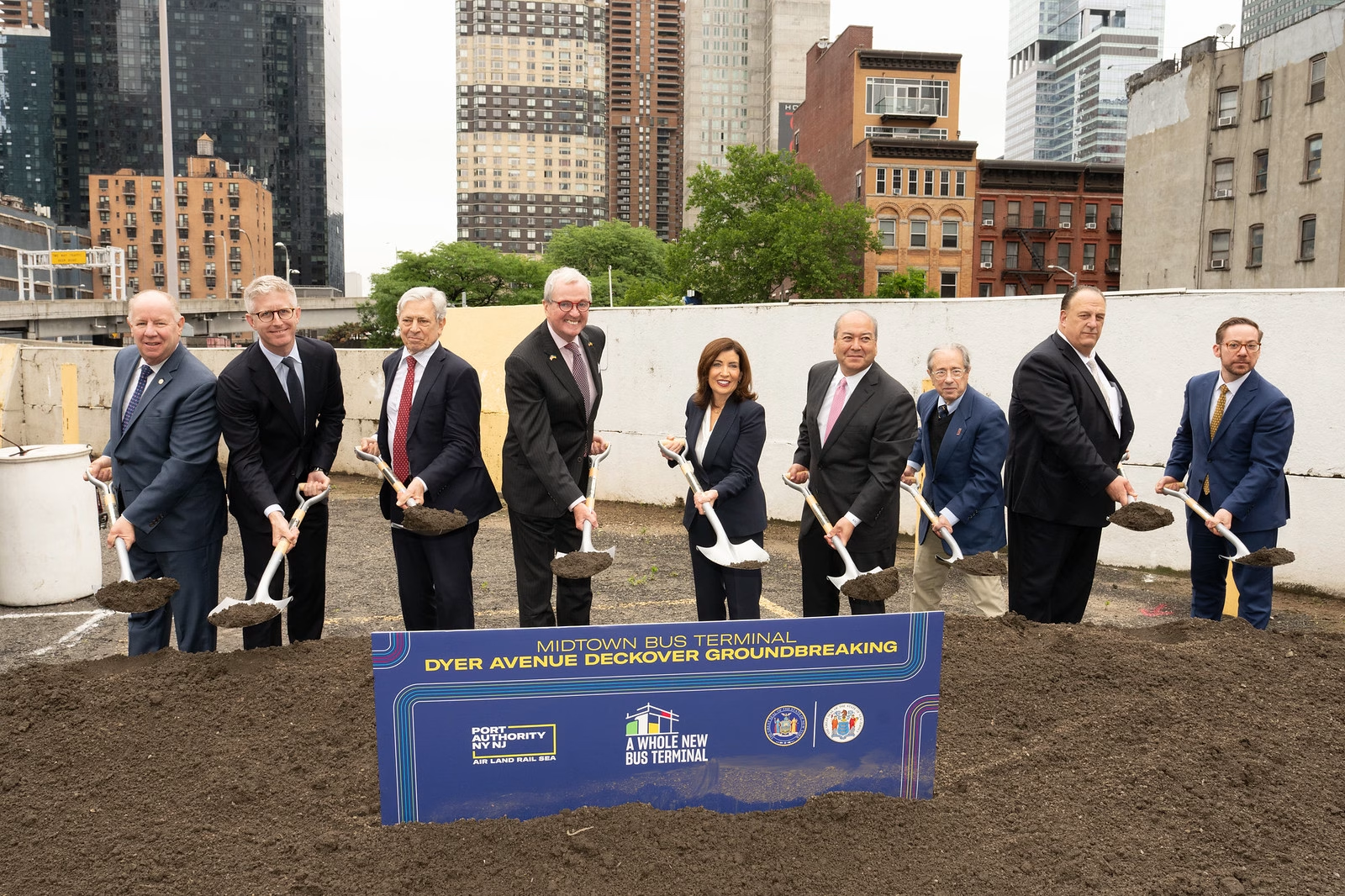Construction has officially begun on the Dyer Avenue deck-overs, kicking off the long-awaited transformation of New York City’s Midtown Bus Terminal. This initial phase sets the stage for replacing the aging, 75-year-old facility with a modern, net-zero emissions transit hub built to meet the region’s future commuting demands.
New York Governor Kathy Hochul, New Jersey Governor Phil Murphy, and leaders from the Port Authority of New York and New Jersey today, May 29 gathered to break ground on the project, which is expected to generate roughly 6,000 union construction jobs and significantly enhance the commuter experience for hundreds of thousands of daily riders.
The Dyer Avenue deck-overs are being constructed above below-grade sections of Dyer Avenue and the Lincoln Tunnel Expressway between West 37th and 39th Streets. Initially serving as staging areas for buses during construction, these decks will later be transformed into 3.5 acres of public green space.
The broader redevelopment plan
The broader $10 billion redevelopment plan includes a new main terminal, a separate bus storage and staging facility, and direct ramps into the Lincoln Tunnel. Design elements feature a multi-story indoor atrium, expanded street-level retail, and a permanently pedestrianized section of 41st Street between Eighth and Ninth Avenues.
“The new Midtown Bus Terminal will breathe new life into this neighborhood and serve as a proud gateway to our city for generations to come,” said Governor Hochul. “It’s a powerful example of what’s possible when government and community work together on modern infrastructure.”
Governor Murphy echoed that sentiment, highlighting the project’s regional importance: “This new terminal will reduce congestion, support economic growth, and dramatically improve the daily commute for thousands in the tri-state area.”

Sustainability Features
Once complete, the facility will be fully electric bus-ready and include smart infrastructure aimed at reducing street-level idling and congestion. The terminal will remain entirely on existing Port Authority property, avoiding the need to acquire private land.
The project reflects extensive feedback from local officials, community boards, commuters, and city agencies. Its phased construction approach begins with the deck-overs, followed by the storage facility, which will also function as a temporary terminal during the main building’s demolition and reconstruction.
“This project is a generational investment in mobility and community,” said NJ TRANSIT President & CEO Kris Kolluri. “It represents a new standard for regional transit — a modern gateway connecting New Jersey and New York.”
Port Authority Chairman Kevin O’Toole called the groundbreaking “a milestone moment” for both states, emphasizing the terminal’s long-term benefits for commuters and the surrounding community.
Read also: NASA Breaks Ground on New Causeway Bridge in Wallops Island, Virginia
Construction Begins on First Phase of New Midtown Bus Terminal with Dyer Avenue Deck-Overs: Factsheet
Project Overview
Total Investment: $10 billion
Current Phase: Dyer Avenue deck-overs construction
Location: Above Dyer Avenue and Lincoln Tunnel Expressway (West 37th-39th Streets)
Jobs Created: ~6,000 union construction positions
Daily Riders Served: Hundreds of thousands
Major Components
Deck-Overs: Initial staging areas converting to 3.5 acres of public green space
New Main Terminal: Modern facility with multi-story indoor atrium
Bus Storage & Staging Facility: Separate facility with direct Lincoln Tunnel ramps
Retail Enhancement: Expanded street-level commercial space
Pedestrian Zone: Permanently pedestrianized 41st Street (8th-9th Avenues)
Sustainability Features in Midtown Bus Terminal Construction
Net-zero emissions design
Full electric bus readiness
Smart infrastructure to reduce street-level idling and congestion
Construction Approach
Phase 1: Dyer Avenue deck-overs (current)
Phase 2: Storage facility construction
And Phase 3: Main terminal demolition and reconstruction
Regional Impact
Reduced traffic congestion
Enhanced economic growth
Improved tri-state area connectivity
Modern gateway between New Jersey and New York
Neighborhood revitalization in Midtown Manhattan
Read also: MTA Begins Construction on New Long Island Rail Road Station in Yaphank, NY

